2006 DODGE RAM SRT-10 display
[x] Cancel search: displayPage 3964 of 5267
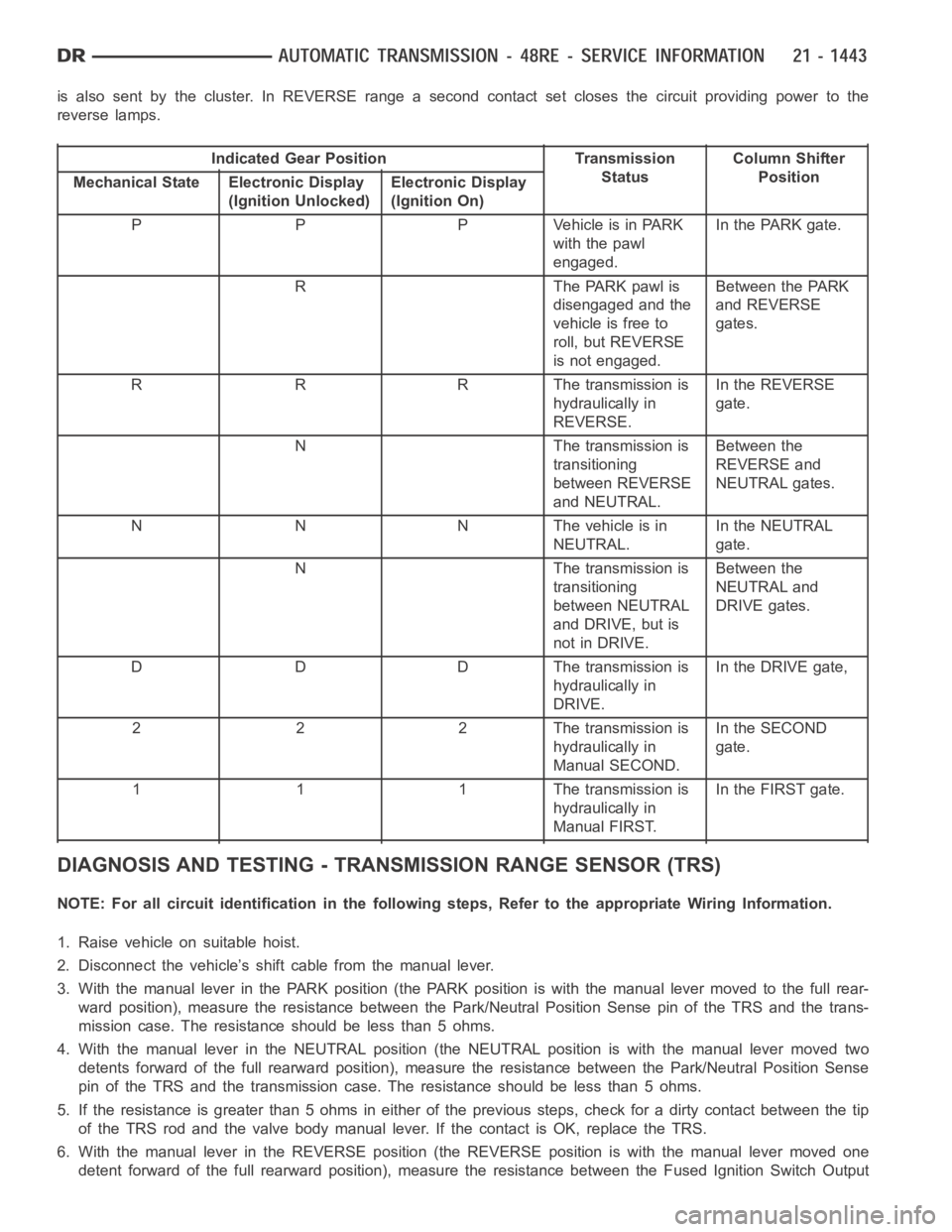
is also sent by the cluster. In REVERSE range a second contact set closes thecircuit providing power to the
reverse lamps.
Indicated Gear Position Transmission
StatusColumn Shifter
Position
Mechanical State Electronic Display
(Ignition Unlocked)Electronic Display
(Ignition On)
P P P Vehicle is in PARK
with the pawl
engaged.In the PARK gate.
R The PARK pawl is
disengaged and the
vehicle is free to
roll, but REVERSE
is not engaged.Between the PARK
and REVERSE
gates.
R R R The transmission is
hydraulically in
REVERSE.In the REVERSE
gate.
N The transmission is
transitioning
between REVERSE
and NEUTRAL.Between the
REVERSE and
NEUTRAL gates.
N N N The vehicle is in
NEUTRAL.In the NEUTRAL
gate.
N The transmission is
transitioning
between NEUTRAL
and DRIVE, but is
not in DRIVE.Between the
NEUTRAL and
DRIVE gates.
D D D The transmission is
hydraulically in
DRIVE.In the DRIVE gate,
2 2 2 The transmission is
hydraulically in
Manual SECOND.In the SECOND
gate.
1 1 1 The transmission is
hydraulically in
Manual FIRST.In the FIRST gate.
DIAGNOSIS AND TESTING - TRANSMISSION RANGE SENSOR (TRS)
NOTE: For all circuit identification in the following steps, Refer to the appropriate Wiring Information.
1. Raise vehicle on suitable hoist.
2. Disconnect the vehicle’s shift cable from the manual lever.
3. With the manual lever in the PARK position (the PARK position is with the manual lever moved to the full rear-
ward position), measure the resistance between the Park/Neutral PositionSensepinoftheTRSandthetrans-
mission case. The resistance should be less than 5 ohms.
4. With the manual lever in the NEUTRAL position (the NEUTRAL position is with the manual lever moved two
detents forward of the full rearward position), measure the resistance between the Park/Neutral Position Sense
pin of the TRS and the transmission case. The resistance should be less than5ohms.
5. If the resistance is greater than 5 ohms in either of the previous steps, check for a dirty contact between the tip
of the TRS rod and the valve body manual lever. If the contact is OK, replace the TRS.
6. With the manual lever in the REVERSE position (the REVERSE position is with the manual lever moved one
detent forward of the full rearward position), measure the resistance between the Fused Ignition Switch Output
Page 4025 of 5267
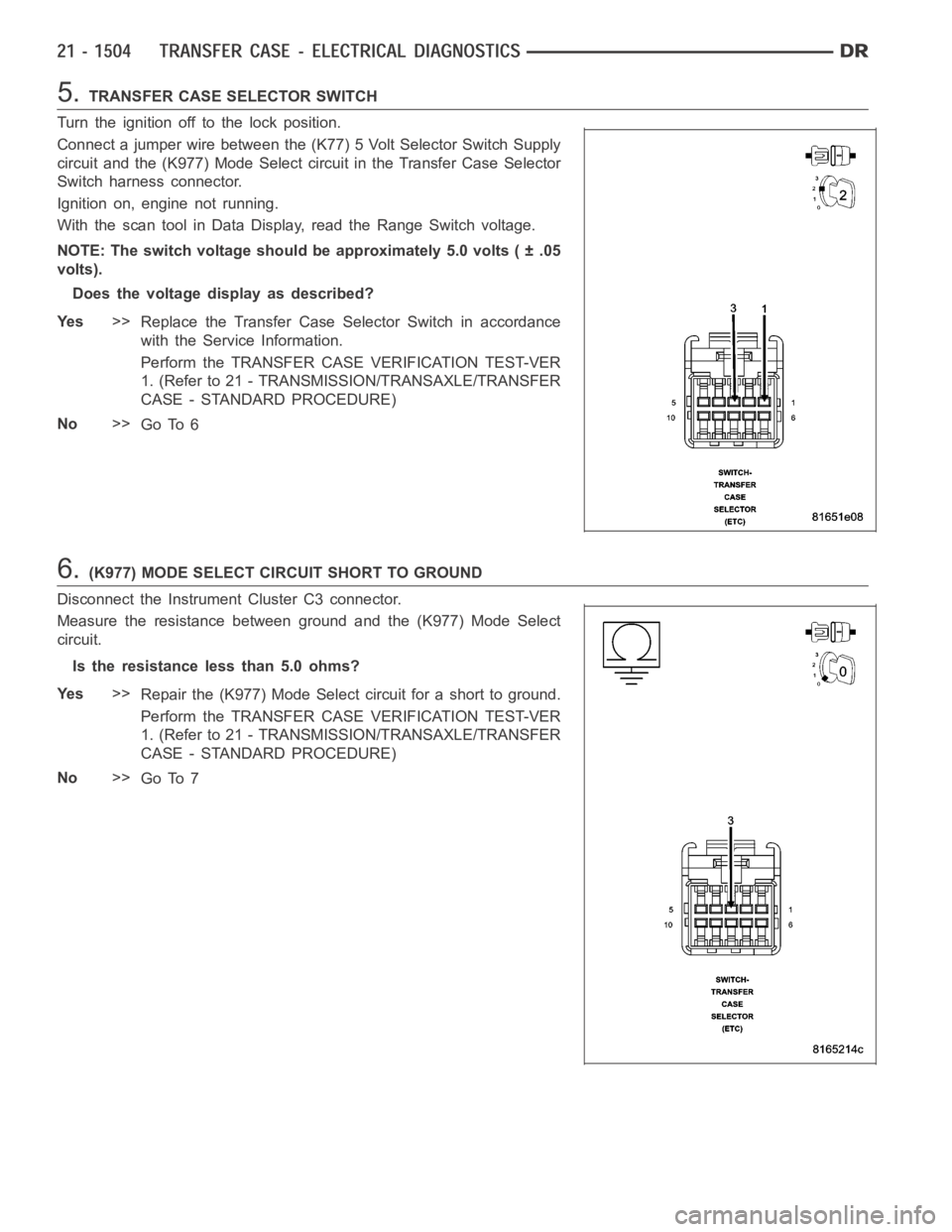
5.TRANSFER CASE SELECTOR SWITCH
Turn the ignition off to the lock position.
Connect a jumper wire between the (K77) 5 Volt Selector Switch Supply
circuit and the (K977) Mode Select circuit in the Transfer Case Selector
Switch harness connector.
Ignition on, engine not running.
With the scan tool in Data Display, read the Range Switch voltage.
NOTE: The switch voltage should be approximately 5.0 volts ( ± .05
volts).
Does the voltage display as described?
Ye s>>
Replace the Transfer Case Selector Switch in accordance
with the Service Information.
Perform the TRANSFER CASE VERIFICATION TEST-VER
1. (Refer to 21 - TRANSMISSION/TRANSAXLE/TRANSFER
CASE - STANDARD PROCEDURE)
No>>
Go To 6
6.(K977) MODE SELECT CIRCUIT SHORT TO GROUND
Disconnect the Instrument Cluster C3 connector.
Measure the resistance between ground and the (K977) Mode Select
circuit.
Is the resistance less than 5.0 ohms?
Ye s>>
Repair the (K977) Mode Select circuit for a short to ground.
Perform the TRANSFER CASE VERIFICATION TEST-VER
1. (Refer to 21 - TRANSMISSION/TRANSAXLE/TRANSFER
CASE - STANDARD PROCEDURE)
No>>
Go To 7
Page 4058 of 5267
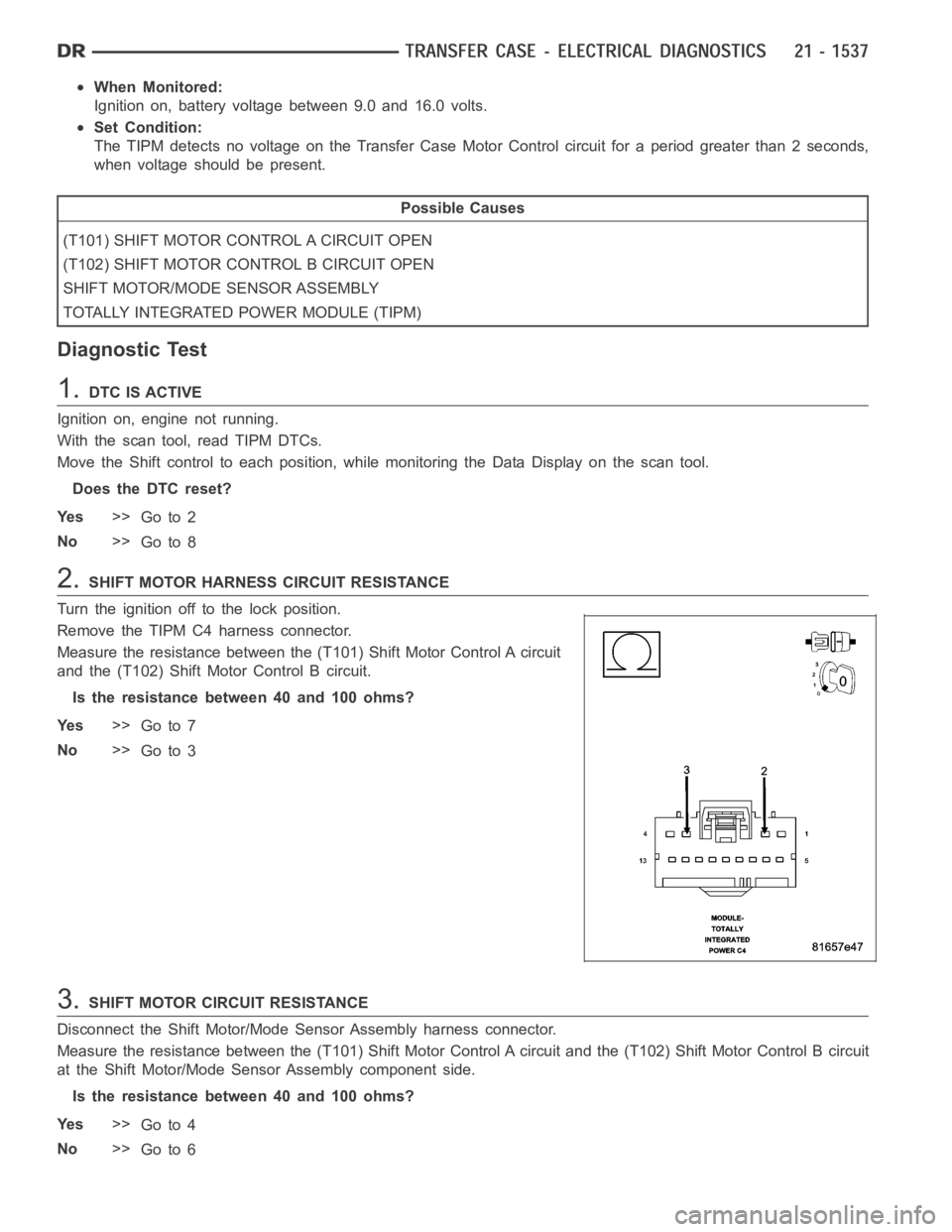
When Monitored:
Ignition on, battery voltage between 9.0 and 16.0 volts.
Set Condition:
The TIPM detects no voltage on the Transfer Case Motor Control circuit for aperiod greater than 2 seconds,
when voltage should be present.
Possible Causes
(T101) SHIFT MOTOR CONTROL A CIRCUIT OPEN
(T102) SHIFT MOTOR CONTROL B CIRCUIT OPEN
SHIFT MOTOR/MODE SENSOR ASSEMBLY
TOTALLY INTEGRATED POWER MODULE (TIPM)
Diagnostic Test
1.DTC IS ACTIVE
Ignition on, engine not running.
With the scan tool, read TIPM DTCs.
Move the Shift control to each position, while monitoring the Data Displayon the scan tool.
Does the DTC reset?
Ye s>>
Go to 2
No>>
Go to 8
2.SHIFT MOTOR HARNESS CIRCUIT RESISTANCE
Turn the ignition off to the lock position.
Remove the TIPM C4 harness connector.
Measure the resistance between the (T101) Shift Motor Control A circuit
and the (T102) Shift Motor Control B circuit.
Is the resistance between 40 and 100 ohms?
Ye s>>
Go to 7
No>>
Go to 3
3.SHIFT MOTOR CIRCUIT RESISTANCE
Disconnect the Shift Motor/Mode Sensor Assembly harness connector.
Measure the resistance between the (T101) Shift Motor Control A circuit and the (T102) Shift Motor Control B circuit
at the Shift Motor/Mode Sensor Assembly component side.
Is the resistance between 40 and 100 ohms?
Ye s>>
Go to 4
No>>
Go to 6
Page 4848 of 5267
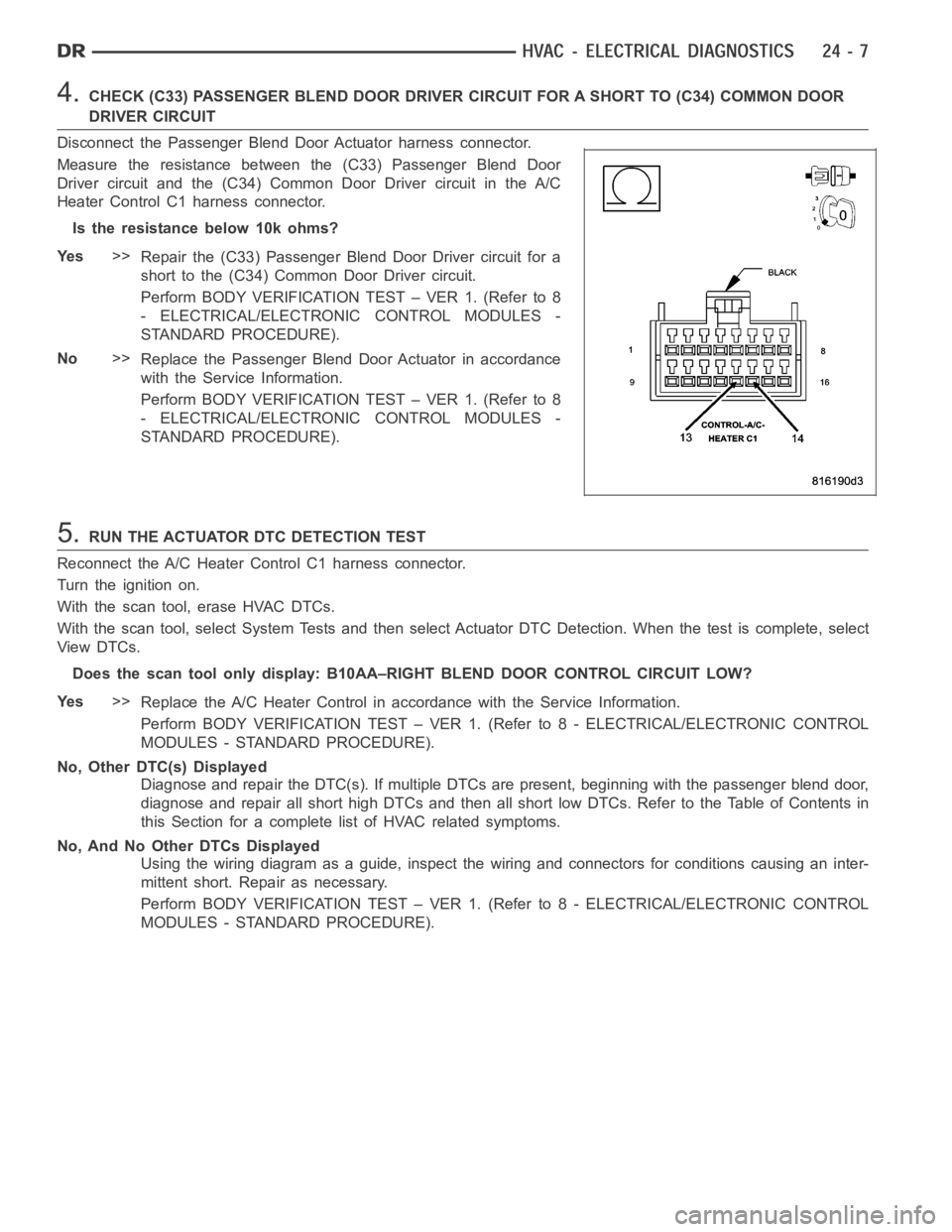
4.CHECK (C33) PASSENGER BLEND DOOR DRIVER CIRCUIT FOR A SHORT TO (C34) COMMONDOOR
DRIVER CIRCUIT
Disconnect the Passenger Blend Door Actuator harness connector.
Measure the resistance between the (C33) Passenger Blend Door
Driver circuit and the (C34) Common Door Driver circuit in the A/C
Heater Control C1 harness connector.
Istheresistancebelow10kohms?
Ye s>>
Repair the (C33) Passenger Blend Door Driver circuit for a
short to the (C34) Common Door Driver circuit.
Perform BODY VERIFICATION TEST – VER 1. (Refer to 8
- ELECTRICAL/ELECTRONIC CONTROL MODULES -
STANDARD PROCEDURE).
No>>
Replace the Passenger Blend Door Actuator in accordance
with the Service Information.
Perform BODY VERIFICATION TEST – VER 1. (Refer to 8
- ELECTRICAL/ELECTRONIC CONTROL MODULES -
STANDARD PROCEDURE).
5.RUN THE ACTUATOR DTC DETECTION TEST
Reconnect the A/C Heater Control C1 harness connector.
Turn the ignition on.
With the scan tool, erase HVAC DTCs.
With the scan tool, select System Tests and then select Actuator DTC Detection. When the test is complete, select
View DTCs.
Does the scan tool only display: B10AA–RIGHT BLEND DOOR CONTROL CIRCUIT LOW?
Ye s>>
Replace the A/C Heater Control in accordance with the Service Information.
Perform BODY VERIFICATION TEST – VER 1. (Refer to 8 - ELECTRICAL/ELECTRONIC CONTROL
MODULES - STANDARD PROCEDURE).
No, Other DTC(s) Displayed
Diagnose and repair the DTC(s). If multiple DTCs are present, beginning with the passenger blend door,
diagnose and repair all short high DTCs and then all short low DTCs. Refer tothe Table of Contents in
this Section for a complete list of HVAC related symptoms.
No, And No Other DTCs Displayed
Using the wiring diagram as a guide, inspect the wiring and connectors for conditions causing an inter-
mittent short. Repair as necessary.
Perform BODY VERIFICATION TEST – VER 1. (Refer to 8 - ELECTRICAL/ELECTRONIC CONTROL
MODULES - STANDARD PROCEDURE).
Page 4850 of 5267
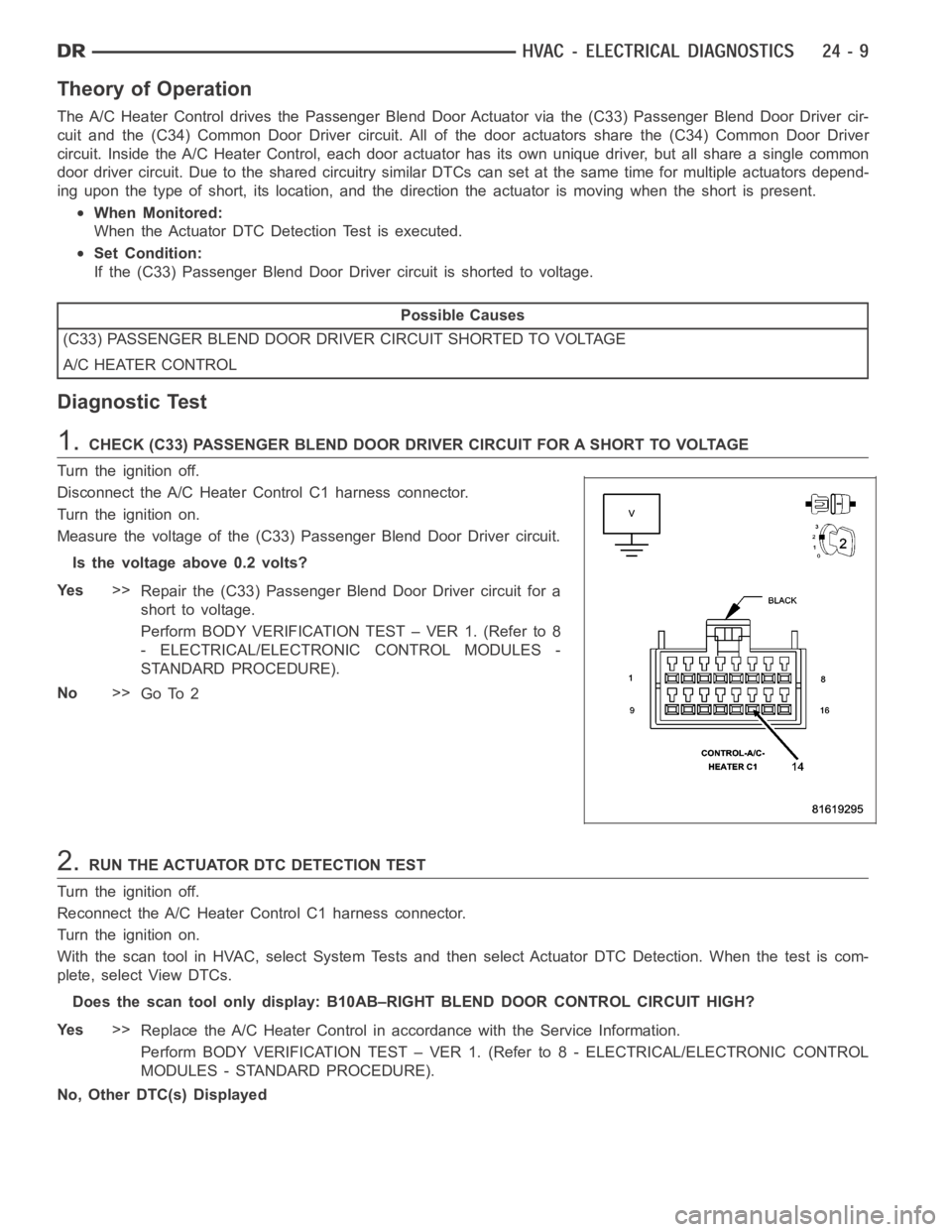
Theory of Operation
The A/C Heater Control drives the Passenger Blend Door Actuator via the (C33) Passenger Blend Door Driver cir-
cuit and the (C34) Common Door Driver circuit. All of the door actuators share the (C34) Common Door Driver
circuit. Inside the A/C Heater Control, each door actuator has its own unique driver, but all share a single common
door driver circuit. Due to the shared circuitry similar DTCs can set at thesame time for multiple actuators depend-
ing upon the type of short, its location, and the direction the actuator is moving when the short is present.
When Monitored:
When the Actuator DTC Detection Test is executed.
Set Condition:
If the (C33) Passenger Blend Door Driver circuit is shorted to voltage.
Possible Causes
(C33) PASSENGER BLEND DOOR DRIVERCIRCUIT SHORTED TO VOLTAGE
A/C HEATER CONTROL
Diagnostic Test
1.CHECK (C33) PASSENGER BLEND DOOR DRIVER CIRCUIT FOR A SHORT TO VOLTAGE
Turn the ignition off.
Disconnect the A/C Heater Control C1 harness connector.
Turn the ignition on.
Measure the voltage of the (C33) Passenger Blend Door Driver circuit.
Is the voltage above 0.2 volts?
Ye s>>
Repair the (C33) Passenger Blend Door Driver circuit for a
short to voltage.
Perform BODY VERIFICATION TEST – VER 1. (Refer to 8
- ELECTRICAL/ELECTRONIC CONTROL MODULES -
STANDARD PROCEDURE).
No>>
Go To 2
2.RUN THE ACTUATOR DTC DETECTION TEST
Turn the ignition off.
Reconnect the A/C Heater Control C1 harness connector.
Turn the ignition on.
With the scan tool in HVAC, select System Tests and then select Actuator DTCDetection. When the test is com-
plete, select View DTCs.
Does the scan tool only display: B10AB–RIGHT BLEND DOOR CONTROL CIRCUIT HIGH?
Ye s>>
Replace the A/C Heater Control in accordance with the Service Information.
Perform BODY VERIFICATION TEST – VER 1. (Refer to 8 - ELECTRICAL/ELECTRONIC CONTROL
MODULES - STANDARD PROCEDURE).
No, Other DTC(s) Displayed
Page 4851 of 5267

Diagnose and repair the DTC(s). If multiple DTCs are present, beginning with the passenger blend door,
diagnose and repair all short high DTCs and then all short low DTCs. Refer tothe Table of Contents in
this Section for a complete list of HVAC related symptoms.
No, And No Other DTCs Displayed
Using the wiring diagram as a guide, inspect the wiring and connectors for conditions causing an inter-
mittent short. Repair as necessary.
Perform BODY VERIFICATION TEST – VER 1. (Refer to 8 - ELECTRICAL/ELECTRONIC CONTROL
MODULES - STANDARD PROCEDURE).
Page 4853 of 5267
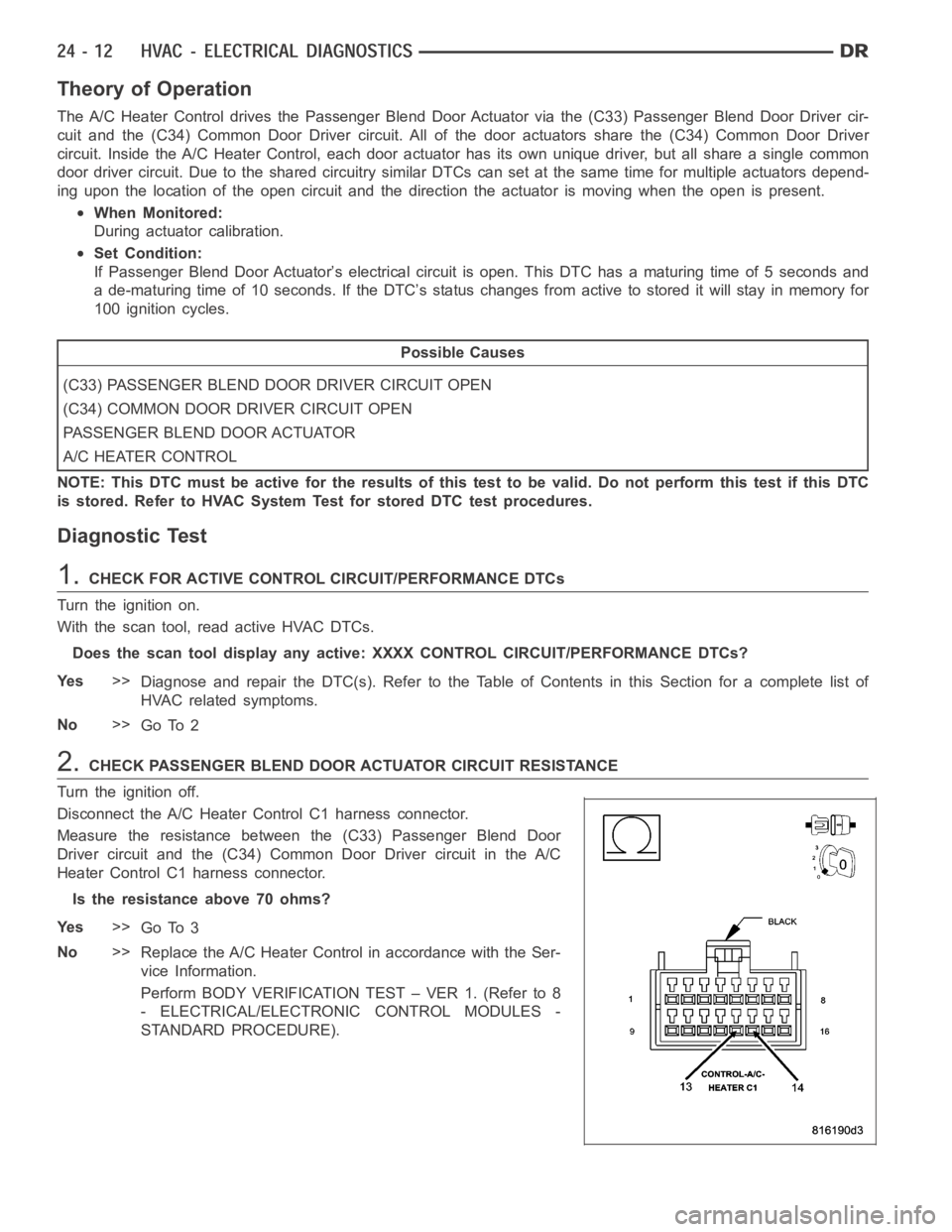
Theory of Operation
The A/C Heater Control drives the Passenger Blend Door Actuator via the (C33) Passenger Blend Door Driver cir-
cuit and the (C34) Common Door Driver circuit. All of the door actuators share the (C34) Common Door Driver
circuit. Inside the A/C Heater Control, each door actuator has its own unique driver, but all share a single common
door driver circuit. Due to the shared circuitry similar DTCs can set at thesame time for multiple actuators depend-
ing upon the location of the open circuit and the direction the actuator is moving when the open is present.
When Monitored:
During actuator calibration.
Set Condition:
If Passenger Blend Door Actuator’s electrical circuit is open. This DTC has a maturing time of 5 seconds and
a de-maturing time of 10 seconds. If the DTC’s status changes from active tostored it will stay in memory for
100 ignition cycles.
Possible Causes
(C33) PASSENGER BLEND DOOR DRIVER CIRCUIT OPEN
(C34) COMMON DOOR DRIVER CIRCUIT OPEN
PASSENGER BLEND DOOR ACTUATOR
A/C HEATER CONTROL
NOTE: This DTC must be active for the results of this test to be valid. Do not perform this test if this DTC
is stored. Refer to HVAC System Test for stored DTC test procedures.
Diagnostic Test
1.CHECK FOR ACTIVE CONTROL CIRCUIT/PERFORMANCE DTCs
Turn the ignition on.
With the scan tool, read active HVAC DTCs.
Does the scan tool display any active: XXXX CONTROL CIRCUIT/PERFORMANCE DTCs?
Ye s>>
Diagnose and repair the DTC(s). Refer to the Table of Contents in this Section for a complete list of
HVAC related symptoms.
No>>
Go To 2
2.CHECK PASSENGER BLEND DOOR ACTUATOR CIRCUIT RESISTANCE
Turn the ignition off.
Disconnect the A/C Heater Control C1 harness connector.
Measure the resistance between the (C33) Passenger Blend Door
Driver circuit and the (C34) Common Door Driver circuit in the A/C
Heater Control C1 harness connector.
Is the resistance above 70 ohms?
Ye s>>
Go To 3
No>>
Replace the A/C Heater Control in accordance with the Ser-
vice Information.
Perform BODY VERIFICATION TEST – VER 1. (Refer to 8
- ELECTRICAL/ELECTRONIC CONTROL MODULES -
STANDARD PROCEDURE).
Page 4855 of 5267
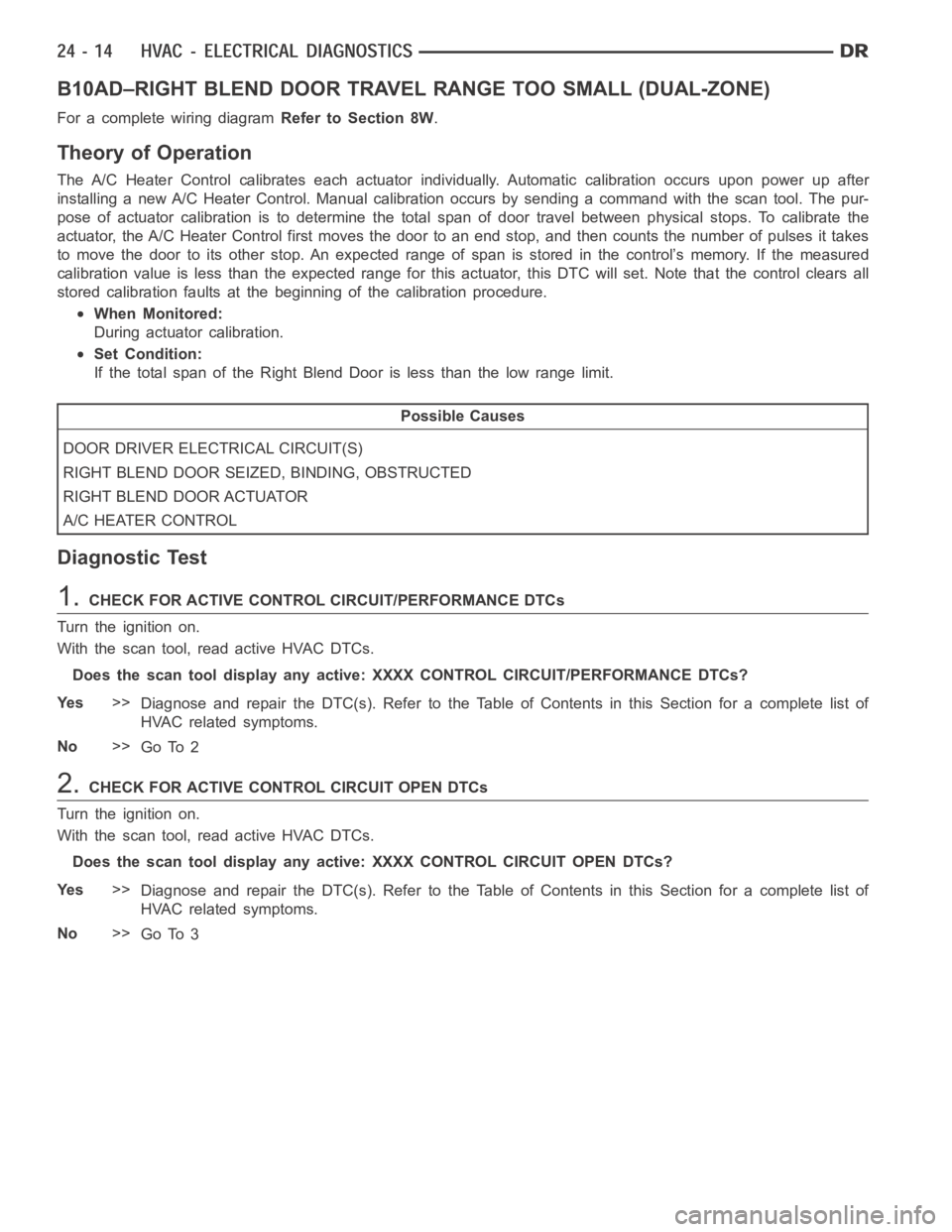
B10AD–RIGHT BLEND DOOR TRAVEL RANGE TOO SMALL (DUAL-ZONE)
For a complete wiring diagramRefer to Section 8W.
Theory of Operation
The A/C Heater Control calibrates each actuator individually. Automaticcalibration occurs upon power up after
installing a new A/C Heater Control. Manual calibration occurs by sendinga command with the scan tool. The pur-
pose of actuator calibration is to determine the total span of door travel between physical stops. To calibrate the
actuator, the A/C Heater Control first moves the door to an end stop, and then counts the number of pulses it takes
to move the door to its other stop. An expected range of span is stored in the control’s memory. If the measured
calibration value is less than the expected range for this actuator, this DTC will set. Note thatthe control clears all
stored calibration faults at the beginning of the calibration procedure.
When Monitored:
During actuator calibration.
Set Condition:
If the total span of the Right Blend Door is less than the low range limit.
Possible Causes
DOOR DRIVER ELECTRICAL CIRCUIT(S)
RIGHT BLEND DOOR SEIZED, BINDING, OBSTRUCTED
RIGHT BLEND DOOR ACTUATOR
A/C HEATER CONTROL
Diagnostic Test
1.CHECK FOR ACTIVE CONTROL CIRCUIT/PERFORMANCE DTCs
Turn the ignition on.
With the scan tool, read active HVAC DTCs.
Does the scan tool display any active: XXXX CONTROL CIRCUIT/PERFORMANCE DTCs?
Ye s>>
Diagnose and repair the DTC(s). Refer to the Table of Contents in this Section for a complete list of
HVAC related symptoms.
No>>
Go To 2
2.CHECK FOR ACTIVE CONTROL CIRCUIT OPEN DTCs
Turn the ignition on.
With the scan tool, read active HVAC DTCs.
Does the scan tool display any active: XXXX CONTROL CIRCUIT OPEN DTCs?
Ye s>>
Diagnose and repair the DTC(s). Refer to the Table of Contents in this Section for a complete list of
HVAC related symptoms.
No>>
Go To 3